3D Printing Materials Market Size
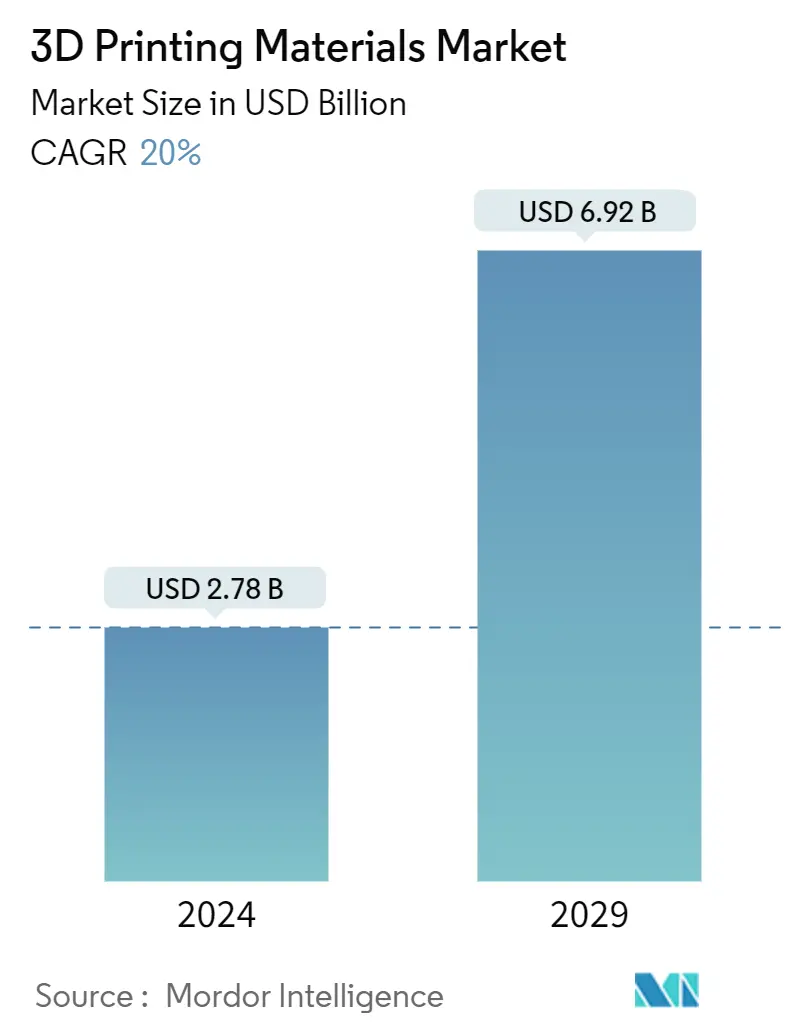
| Study Period | 2019 - 2029 |
| Market Size (2024) | USD 2.78 Billion |
| Market Size (2029) | USD 6.92 Billion |
| CAGR (2024 - 2029) | 20.00 % |
| Fastest Growing Market | Asia Pacific |
| Largest Market | North America |
Major Players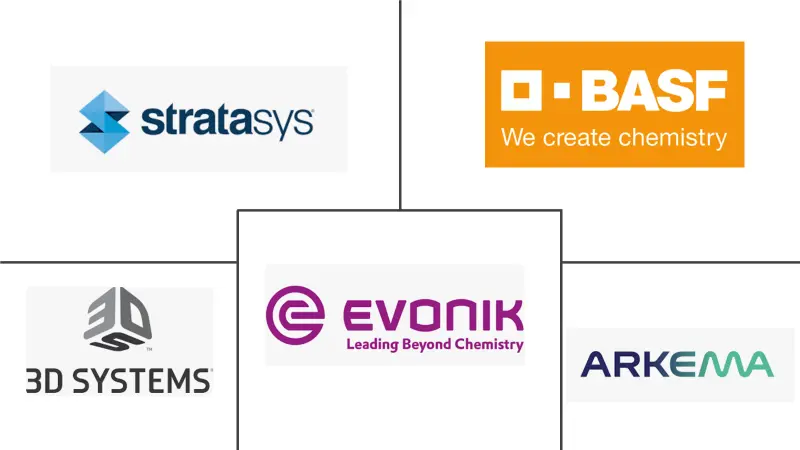
*Disclaimer: Major Players sorted in no particular order |
3D Printing Materials Market Analysis
The 3D Printing Materials Market size is estimated at USD 2.78 billion in 2024, and is expected to reach USD 6.92 billion by 2029, growing at a CAGR of 20% during the forecast period (2024-2029).
With the outbreak of the COVID-19 pandemic, the 3D printing materials market suffered due to the disruption in the supply chain, resulting in delays in several projects. Moreover, disrupted financial flows and strict lockdowns in various countries, resulting in growing absenteeism among production line workers, affected the market adversely. However, the market rebounded in 2021 due to increased demand from the automotive industry.
- The major factors driving the market growth are the surge in demand for manufacturing applications, mass customization associated with 3D printing, and the surge in demand for automotive applications.
- On the flip side, high equipment and material costs and limited materials availability will likely hinder the market's growth.
- Introducing new materials, like graphene, opens up new applications, and adopting 3D printing technology in home printing is expected to create new opportunities for the 3D printing materials market.
3D Printing Materials Market Trends
Increasing Applications in the Automotive Industry
- 3D printing materials are extensively used in the automotive industry to manufacture scaled models for testing. They are also used for components, such as bellows, front bumper, air conditioning ducting, suspension wishbone, dashboard interface, alternator mounting bracket, battery cover, etc. Automotive OEM manufacturers are using 3D printing materials for rapid prototyping.
- Due to the advantages of the 3D printing process, such as low cost, less manufacturing time, reduced material wastage, etc., automotive manufacturers are moving toward this process. Some of the largest automotive manufacturers in the world, such as AUDI, Rolls Royce, Porsche, Hackrod, and many others, are using these materials for manufacturing spare parts and metal prototypes.
- The Chinese automotive manufacturing industry is the largest in the world. According to the China Association of Automobile Manufacturers (CAAM), In March 2023, the production and sales of automobiles accounted for 2.584 million and 2.451 million units, respectively, with an increase of 27.2% and 24% respectively on the month every month and an increase of 15.3% and 9.7% respectively on a year-on-year basis.
- According to the China Association of Automobile Manufacturers (CAAM), from January to March of 2023, passenger cars production and sales accounted for 5.262 million and 5.138 million units, respectively, with an increase of 4.3% and 7.3%, respectively, on a year-on-year basis. Similarly, commercial vehicle production and sales accounted for 948000 and 938000 units, respectively, with an increase of 3.9% and 2.9% year-on-year.
- According to the International Organization of Motor Vehicle Manufacturers(OICA), the world's total passenger car production in 2022 was 61,598,650; in 2021, it was 57,054,295 units. The demand for vehicles is expected to rise due to several factors, such as increased demand for private mobility and exponential growth in electric vehicles during the forecast period.
- The demand for 3D printing materials in the automotive industry is expected to grow due to the above factors.
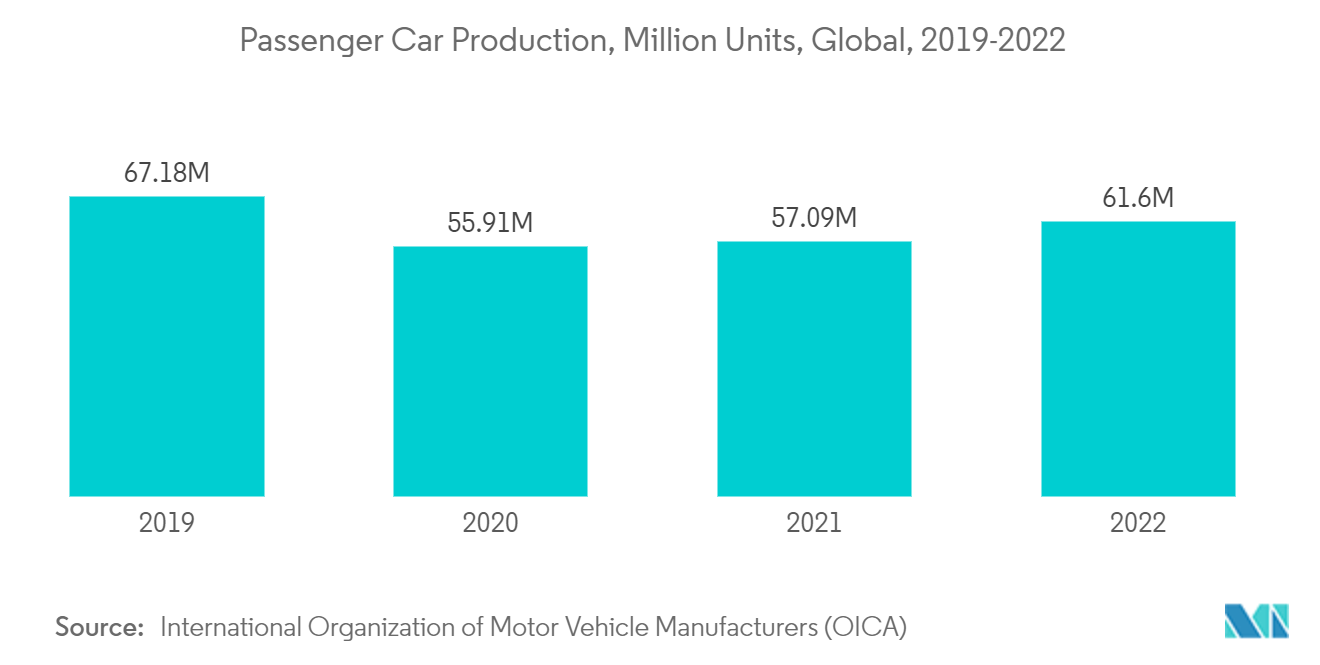
Asia-Pacific is Expected to Grow at a Fastest Rate
- Asia-Pacific is among the fastest-growing economies globally, comprising China as one of the fastest-growing countries globally, and almost all the end-user industries have been growing due to the rising population, living standards, and per capita income.
- The region comprises several countries with noteworthy production in the automotive sector. Moreover, the emergence of electric vehicles is expected to further provide substantial growth opportunities in the 3D printing materials market.
- In 2022, several countries, such as India, Indonesia, Malaysia, and Vietnam, were expected to grow tremendously in automotive production. For instance, according to the International Organization of Motor Vehicle Manufacturers (OICA), in 2022, the total production of motor vehicles in India and Indonesia stood at 5,456,857 and 1,470,146 units, respectively, showing growth of 24% and 31% compared to the previous year.
- On September 20, 2022, the Ministry of Finance (MOF), the Ministry of Industry and Information Technology (MIIT), and the State Taxation Administration (STA) jointly announced that the purchase of new energy vehicles (NEVs) from January 2023 to December 2023 would be exempt from the vehicle purchase tax. This supports the demand for and sales of new electric vehicles in China.
- Furthermore, the layer-by-layer deposition process in 3D printing allows sensors, antennas, and other functional electronics to be printed directly onto plastic components, metal surfaces, glass panels, and ceramic materials.
- According to a report by the China Academy of Information and Communications Technology, during the first two months of 2022, the electronics manufacturing industry maintained a steady expansion. The added value of major electronics manufacturers from January to February 2022 increased by 12.7% yearly; however, overall industrial growth stood at 7.5% during the same period.
- China is among the fastest-growing markets regarding new technologies and using innovative materials for construction. With China's dominating role as a global construction center, the accelerated development of 3D printing in the home printing sector is likely to revolutionize the traditional construction industry in the country, with applications ranging from residential buildings to monuments. The country managed to 3D print homes and other large-scale structures, making every other country look into the possibilities of 3D printing in construction.
- There are a few limitations to 3D printing in the construction sector, such as a lack of confidence from building developers and the absence of proper regulations for using this technology. However, with increasing awareness of new technologies and their advantages, organizations, and individuals are increasingly considering cost-saving alternatives. This, in turn, is driving demand in the 3D printing materials market in the country.
- Owing to all the abovementioned factors, the demand for 3D printing materials in Asia-Pacific is expected to drive the market studied.
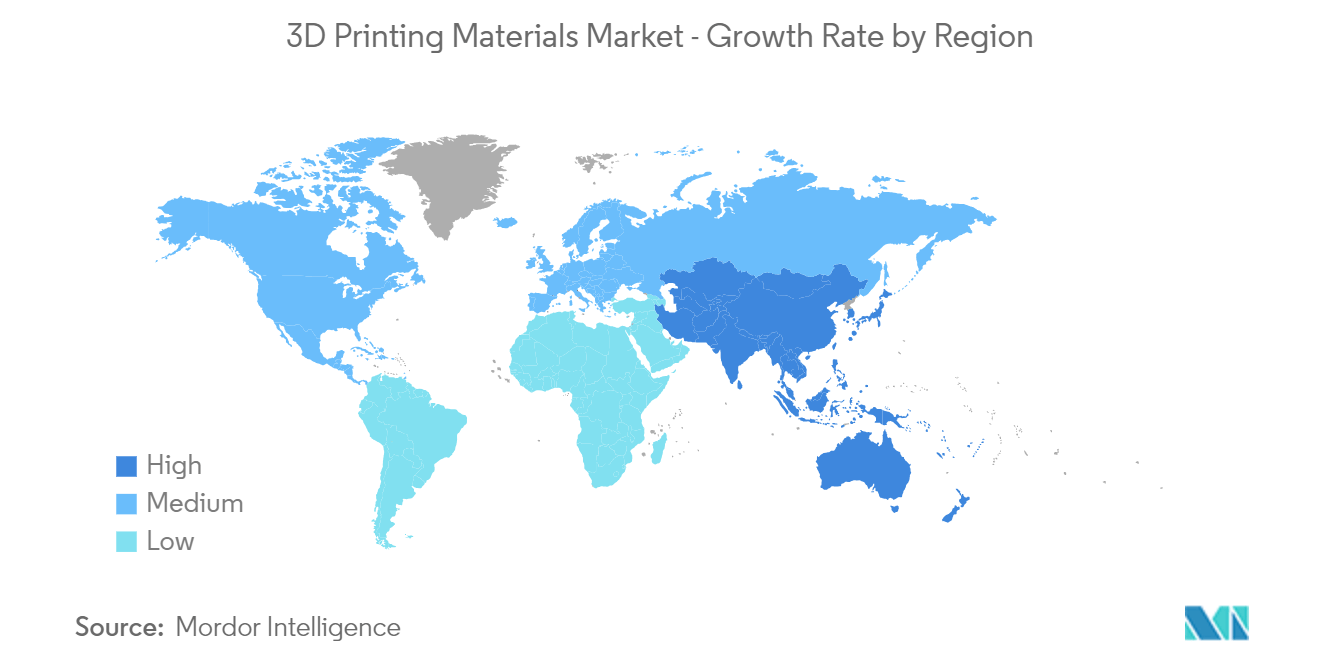
3D Printing Materials Industry Overview
The 3D printing materials market is consolidated, with few players holding the major share in the market. Key players in the 3D printing materials market (not in any particular order) include Stratasys, BASF SE, Evonik Industries AG, Arkema, and 3D Systems Inc., among others.
3D Printing Materials Market Leaders
-
3D Systems, Inc.
-
Stratasys
-
BASF SE
-
Evonik Industries AG
-
Arkema
*Disclaimer: Major Players sorted in no particular order
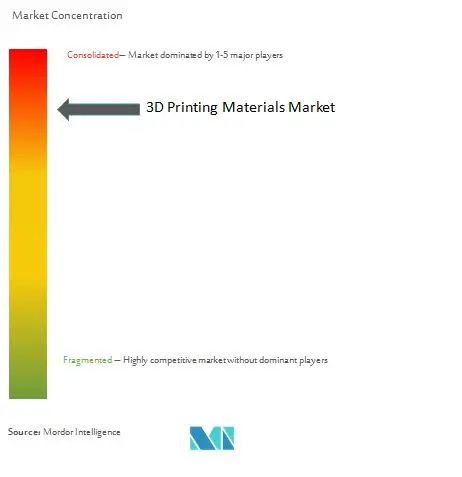
3D Printing Materials Market News
- April 2023: Stratasys acquired Covestro AG's additive manufacturing materials business. The acquisition comprises of product portfolio of nearly 60 additive manufacturing materials, R&D facilities, global development and sales teams across Asia, the U.S., and Europe, and a wide range of IP portfolios, including hundreds of patents and pending patents. This acquisition helped the company to expand its product portfolio of 3D printing materials.
- September 2022: SABIC announced a new flame-retardant 3D printing material LNP THERMOCOMP AM DC0041XA51, to be used in the railway industry. The company debuted the material at Berlin's InnoTrans 2022.
3D Printing Materials Market Report - Table of Contents
1. INTRODUCTION
- 1.1 Study Assumptions
- 1.2 Scope of the Study
2. RESEARCH METHODOLOGY
3. EXECUTIVE SUMMARY
4. MARKET DYNAMICS
-
4.1 Drivers
- 4.1.1 Growing Usage in Manufacturing Applications
- 4.1.2 Mass Customization Associated with 3D Printing
- 4.1.3 Surge in Demand in Automotive Application
-
4.2 Restraints
- 4.2.1 High Equipment and Material Cost
- 4.2.2 Availability of Limited Types of Materials
- 4.3 Industry Value Chain Analysis
-
4.4 Porter's Five Forces Analysis
- 4.4.1 Bargaining Power of Suppliers
- 4.4.2 Bargaining Power of Consumers
- 4.4.3 Threat of New Entrants
- 4.4.4 Threat of Substitute Products and Services
- 4.4.5 Degree of Competition
5. MARKET SEGMENTATION (Market Size in Value)
-
5.1 Material Type
- 5.1.1 Plastics
- 5.1.1.1 Acrylonitrile Butadiene Styrene (ABS)
- 5.1.1.2 Polylactic Acid (PLA)
- 5.1.1.3 Nylon
- 5.1.1.4 Polyamide
- 5.1.1.5 Polycarbonates
- 5.1.1.6 Other Plastics
- 5.1.2 Ceramics
- 5.1.3 Metals
- 5.1.4 Other Material Types
-
5.2 Form
- 5.2.1 Powder
- 5.2.2 Filament
- 5.2.3 Liquid
-
5.3 End-user Industry
- 5.3.1 Automotive
- 5.3.2 Medical
- 5.3.3 Aerospace and Defense
- 5.3.4 Consumer Electronics
- 5.3.5 Other End-user Industries
-
5.4 Geography
- 5.4.1 Asia-Pacific
- 5.4.1.1 China
- 5.4.1.2 India
- 5.4.1.3 Japan
- 5.4.1.4 South Korea
- 5.4.1.5 Singapore
- 5.4.1.6 Rest of Asia-Pacific
- 5.4.2 North America
- 5.4.2.1 United States
- 5.4.2.2 Canada
- 5.4.2.3 Mexico
- 5.4.3 Europe
- 5.4.3.1 Germany
- 5.4.3.2 United Kingdom
- 5.4.3.3 Italy
- 5.4.3.4 France
- 5.4.3.5 Russia
- 5.4.3.6 Rest of Europe
- 5.4.4 South America
- 5.4.4.1 Brazil
- 5.4.4.2 Argentina
- 5.4.4.3 Rest of South America
- 5.4.5 Middle-East and Africa
- 5.4.5.1 Saudi Arabia
- 5.4.5.2 South Africa
- 5.4.5.3 Rest of Middle-East and Africa
6. COMPETITIVE LANDSCAPE
- 6.1 Mergers and Acquisitions, Joint Ventures, Collaborations, and Agreements
- 6.2 Market Share (%)**/Ranking Analysis
- 6.3 Strategies Adopted by Leading Players
-
6.4 Company Profiles
- 6.4.1 3D Systems, Inc.
- 6.4.2 Arkema
- 6.4.3 BASF SE
- 6.4.4 CRP TECHNOLOGY S.r.l.
- 6.4.5 CRS Holdings, LLC
- 6.4.6 ENVISIONTEC US LLC
- 6.4.7 EOS
- 6.4.8 Evonik Industries AG
- 6.4.9 General Electric
- 6.4.10 Henkel AG & Co. KGaA
- 6.4.11 Höganäs AB
- 6.4.12 Materialise
- 6.4.13 Sandvik AB
- 6.4.14 Solvay
- 6.4.15 Stratasys
- *List Not Exhaustive
7. MARKET OPPORTUNITIES AND FUTURE TRENDS
- 7.1 Introduction of New Materials, like Graphene Opens Up New Applications
- 7.2 Adoption of 3D Printing Technology in Home Printing
3D Printing Materials Industry Segmentation
3D printing materials are generally used in 3D printing applications, such as manufacturing different parts using a computer-created design. 3D printing materials have distinctive properties, textures, features, and types that allow for choices for the particular project. The 3D printing materials market is segmented by material type, form, end-user industry, and geography. By material type, the market is segmented into plastics (acrylonitrile butadiene styrene (ABS), polylactic acid (PLA), nylon, polyamide, polycarbonates, and other plastics), ceramics, metals, and other material types. The market is segmented by form into powder, filament, and liquid. The end-user industry segments the market into automotive, medical, aerospace and defense, consumer electronics, and other industries. The report also covers the market sizes and forecasts for the 3D printing materials market in 17 countries across the major regions. Market sizing and forecasts have been done for each segment based on revenue (USD).
| Material Type | Plastics | Acrylonitrile Butadiene Styrene (ABS) |
| Polylactic Acid (PLA) | ||
| Nylon | ||
| Polyamide | ||
| Polycarbonates | ||
| Other Plastics | ||
| Material Type | Ceramics | |
| Metals | ||
| Other Material Types | ||
| Form | Powder | |
| Filament | ||
| Liquid | ||
| End-user Industry | Automotive | |
| Medical | ||
| Aerospace and Defense | ||
| Consumer Electronics | ||
| Other End-user Industries | ||
| Geography | Asia-Pacific | China |
| India | ||
| Japan | ||
| South Korea | ||
| Singapore | ||
| Rest of Asia-Pacific | ||
| Geography | North America | United States |
| Canada | ||
| Mexico | ||
| Geography | Europe | Germany |
| United Kingdom | ||
| Italy | ||
| France | ||
| Russia | ||
| Rest of Europe | ||
| Geography | South America | Brazil |
| Argentina | ||
| Rest of South America | ||
| Geography | Middle-East and Africa | Saudi Arabia |
| South Africa | ||
| Rest of Middle-East and Africa |
3D Printing Materials Market Research FAQs
How big is the 3D Printing Materials Market?
The 3D Printing Materials Market size is expected to reach USD 2.78 billion in 2024 and grow at a CAGR of 20% to reach USD 6.92 billion by 2029.
What is the current 3D Printing Materials Market size?
In 2024, the 3D Printing Materials Market size is expected to reach USD 2.78 billion.
Who are the key players in 3D Printing Materials Market?
3D Systems, Inc., Stratasys, BASF SE, Evonik Industries AG and Arkema are the major companies operating in the 3D Printing Materials Market.
Which is the fastest growing region in 3D Printing Materials Market?
Asia Pacific is estimated to grow at the highest CAGR over the forecast period (2024-2029).
Which region has the biggest share in 3D Printing Materials Market?
In 2024, the North America accounts for the largest market share in 3D Printing Materials Market.
3D Printing Materials Industry Report
Statistics for the 2024 3D Printing Materials market share, size and revenue growth rate, created by Mordor Intelligence™ Industry Reports. 3D Printing Materials analysis includes a market forecast outlook to for 2024 to 2029 and historical overview. Get a sample of this industry analysis as a free report PDF download.



